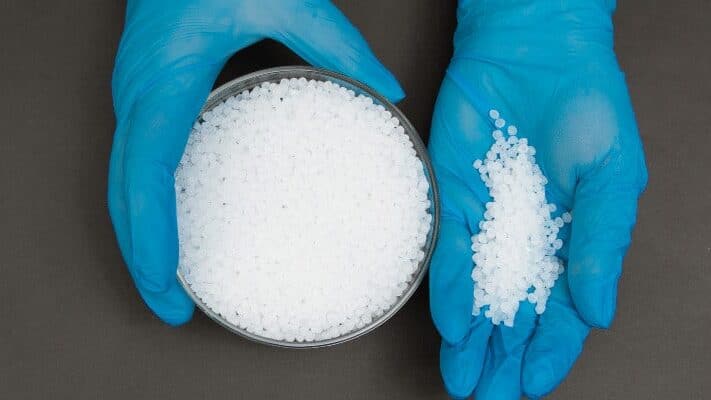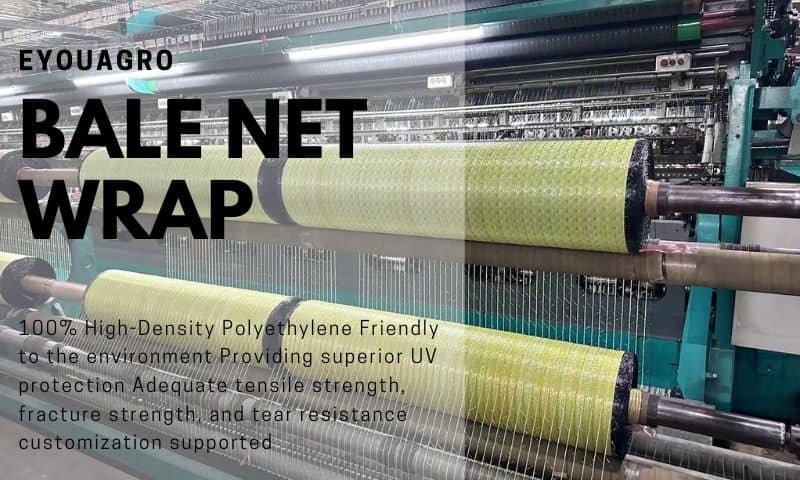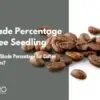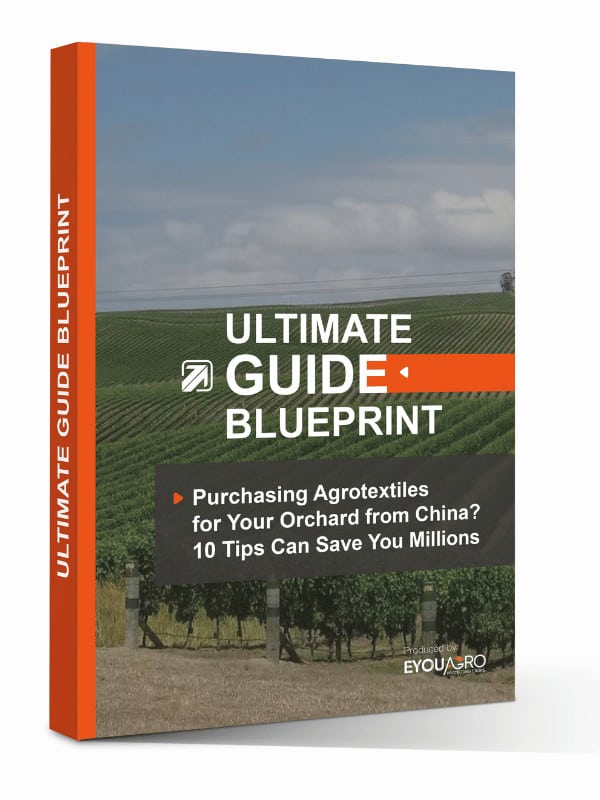Introduction
In the bustling world of agriculture, efficiency, and durability are key.
Bale net wraps and high-quality silage bales play an integral role in this dynamic environment, offering solutions that not only increase productivity but also ensure crop safety.
Bale netwrap replace the plastic twine and sisal twine used in the past and play a very important role in the storage of hay.
This article will explore the critical aspects of bale net wrap, from its definition to its application, benefits, selection, and usage.

What is Bale Netwrap?
Bale netwrap is a net-like material typically used to wrap and secure round or square bales of hay, straw, or silage. It aids in protecting the crop from adverse weather conditions and pests, ensuring that the bale maintains its shape during transport and storage.
The Material Composition of Bale Netwrap
Bale netwrap/round bale protects is predominantly made of high-density polyethylene (HDPE), a durable, resilient material known for its exceptional resistance to environmental stressors. The inherent properties of HDPE make it suitable for long-term outdoor usage. Its UV resistance ensures that the bale netwrap will retain its integrity and strength, even when exposed to prolonged sunlight.

Function and Advantages of Bale Netwrap
At its core, bale netwrap serves to secure and protect baled crops. It accomplishes this by forming a tight, protective barrier around each bale, shielding it from potential threats.
Protection Against Weather and Pests
The robust nature of the bale netwrap offers excellent protection against environmental elements. It safeguards the bales from damaging moisture, harmful UV rays, and invading pests, which could otherwise compromise the quality of the crops.
Streamlining the Baling Process
Beyond protection, bale netwrap streamlines the baling process. Facilitating faster and more efficient wrapping, significantly accelerates operations, allowing for greater productivity within the same timeframe.
Advantages
The use of bale netwrap brings with it several tangible advantages:
Increased Efficiency:
Time is a precious commodity in the agriculture industry. Bale netwrap expedites the wrapping process, allowing for more bales to be produced and secured within a shorter period. This improved speed translates directly into increased operational efficiency, allowing farmers to get more done within the same timeframe.

Reduced Losses:
Bale netwrap ensures a tight, secure wrap around each bale. This minimizes losses during handling, transportation, and storage due to spillage or disintegration of the bales. It also protects against weather damage and pests, preventing losses due to degradation of the crops.
Improved Quality:
Bale netwrap plays a vital role in maintaining the nutritional quality of the baled crops. By providing a robust protective barrier, it helps to preserve the integrity and nutritional content of the hay, straw, or silage within the bale. This results in superior quality animal feed, ultimately leading to better livestock health and productivity.
In conclusion, the use of bale netwrap is a strategic investment that pays off through streamlined operations, reduced waste, and improved quality of the final product.
Common Applications of Bale Netwrap in the Agriculture
In addition to the protection and structural benefits it provides to bales, bale netwrap is primarily utilized in several key sectors of agriculture:
Hay Production:
Bale netwrap is extensively used in the hay production industry. Once hay has been cut, dried, and baled, netwrap is applied to protect the bales from moisture and other environmental elements that can cause hay to mold or lose nutritional value. The netwrap also keeps the hay in a compact form, making it easier to handle, transport, and store.

Straw and Silage Baling
Similarly, netwrap is used for straw and silage bales. It protects the bales from the elements, maintains their shape, and helps to preserve the nutrient value of the crops. This is particularly important for silage bales, as the fermentation process required to produce silage needs airtight conditions, which good-quality netwrap can provide.
Livestock Farming
In livestock farming, netwrap stores feed for the colder months when fresh grass may not be available. This practice helps ensure a steady supply of nutrition for the animals throughout the year.
Biomass and Renewable Energy
In recent years, bale netwrap has found applications in the biomass and renewable energy sector. Crops and organic waste materials can be baled and wrapped using netwrap for transport to bioenergy plants, where they are used for producing biofuel or generating electricity.
In each of these applications, the value of bale netwrap lies not only in its protective properties but also in its ability to maintain bale integrity, improve handling efficiency, and reduce losses during storage and transportation.

How to Use round bale protects
Using bale netwrap involves a straightforward process but requires attention to detail. It’s crucial to load the netwrap correctly onto the baler and to ensure the bales are formed to the ideal size and shape for wrapping. Once the bales are wrapped, they should be stored in an area that minimizes exposure to extreme weather conditions.
When using Bale netwrap, ensure to:
- Follow the baler’s instructions for loading and applying the netwrap.
- Regularly inspect the netwrap for any damage.
- Store the wrapped bales appropriately to maximize their shelf life.
Importance of Quality Bale Net Wrap for Hay
The quality of the bale netwrap significantly impacts its effectiveness and the resultant agricultural output. High-quality netwrap ensures better protection for the bales, fewer interruptions during the baling process due to breakages, and ultimately less crop wastage.
Comparatively, lower-quality netwrap may have inconsistent mesh sizes, lack UV resistance, or suffer from frequent tearing, which can lead to reduced efficiency and potential losses.

How to Select Bale Netwrap
When choosing a net wrap for a round bale, consider the following:
Material Quality
Opt for netwrap made from UV-resistant, durable material like HDPE. Another key point is whether the UV stabilizer is added to the product.
Size and Specifications
Choose the size (To the edge coverage or Over the edge coverage) and specification that fits your baler, fully covers the bale surface, and meets the needs of your crop type.

Compatibility
Ensure that the netwrap is compatible with your specific baling equipment.
FAQs
Q1: What is baler net wrap made of?
A: Bale netwrap is typically made from High-Density Polyethylene (HDPE), a strong and durable material that can withstand harsh weather conditions and prolonged sun exposure.
Q2: How much netwrap do I need per bale?
A: The amount of netwrap needed can vary based on the size of the bale and the type of crop. However, a good rule of thumb is to have at least 2-3 revolutions of netwrap per bale to ensure it’s adequately covered and secure.
Q3: Can I use bale netwrap with any baler?
A: Bale netwrap is designed to be compatible with most round and square balers. However, it’s best to check your baler’s manual or consult the manufacturer to confirm.
Q4: How should I store my bales after using netwrap?
A: Bales should be stored in a dry, protected area to avoid potential damage from weather or pests. Even though netwrap provides substantial protection, a good storage practice helps extend the life of the bales.

Q5: Why is my netwrap breaking during the baling process?
A: Netwrap breakage can be caused by several issues. These include incorrect tension settings, sharp edges on the baler, poor-quality netwrap, or overly dry or wet crop conditions. If you’re experiencing regular breakages, it may be worth having your baler inspected or trying a different netwrap product.
Q6: What is the difference between netwrap and twine for baling?
A: Netwrap and twine both serve to secure bales, but they differ in several ways. Netwrap typically provides a better seal, improves bale shape and stability, and speeds up the baling process. Twine, while often cheaper, may take longer to apply and provide less protection.
Q7: How many bales can you pack in a bale net wrap?
We can calculate it according to the formula: First, you need to know the diameter of your bale. Suppose: the length of a bale net is “L,” the bale diameter is “D,” and each bale needs to be rolled “N” times. Then the number of bales that can be packed in a roll is about: L / (3.14xDxN).
For example, the length of a roll of bale net wrap is 3000 meters. The bales of silages are 4′ (1.23m) in diameter. You need to make three rounds per pack. So we calculate according to the formula: 3000/ (3.14×1.23×3) = 258(packets).
So, according to this, a roll of bale net wrap of 3000 meters can pack about 258 bales.

Conclusion
Bale netwrap is an invaluable tool in modern agriculture, streamlining operations and ensuring crop safety.
While selection requires careful consideration of various factors, the benefits offered by a high-quality bale netwrap make it a worthy investment.
EyouAgro: Your Reliable Partner for Quality Bale Netwrap

EyouAgro is a leading manufacturer of high-quality bale netwrap. Our commitment to quality, innovation, and customer satisfaction has established us as a trusted partner for farmers worldwide.
Choose EyouAgro for durable, reliable, and efficient solutions in agricultural netting.
Visit our website and contact us to explore our range of products today!









